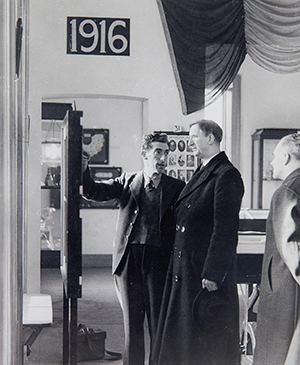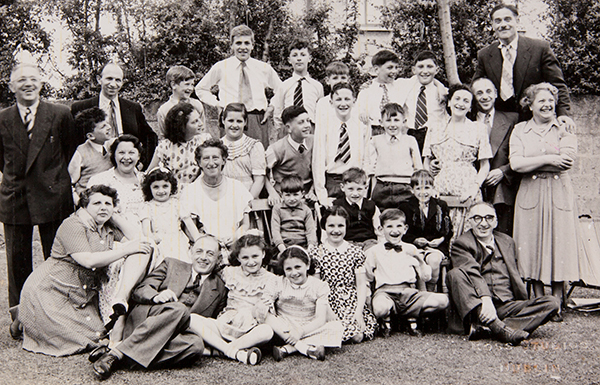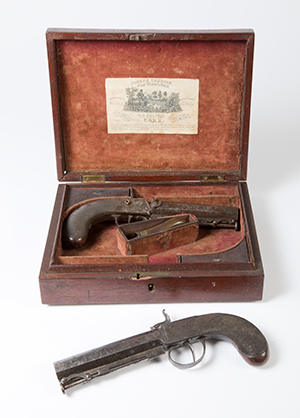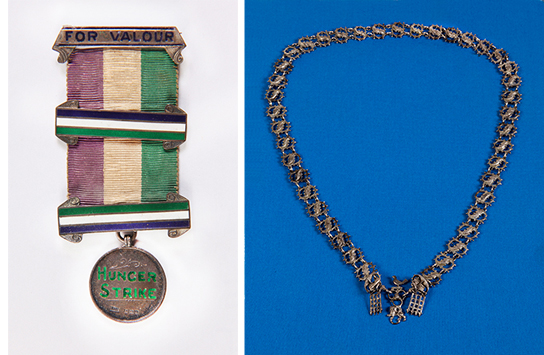Cork Public Museum—a virtual tour
Published in Issue 1 (January/February 2021), Reviews, Volume 29corkcity.ie/en/cork-public-museum
By Tony Canavan

Above: The museum’s first curator, M.J. O’Kelly (1945–63), with Eamon de Valera in 1946.
The introduction of Level 5 Covid restrictions has resulted in the closure of museums and galleries. For many that has meant a reliance on their online presence to allow the public to view exhibitions or ‘visit’ the museum. I have looked through the websites of various museums across Ireland and found the Cork Public Museum website to be an attractive and lively one that presents lots of information on the museum and its collections.
By clicking ‘Explore’ you can get a rundown of the various collections to be found there: Archaeology, Civic History, Social and Economic History, Political and Military History, Natural Sciences, and Photographic/Image. Just as in the museum itself, you could either spend a lot of time going through the entire website or simply skim through picking out highlights. Each section is accompanied by text which not only explains what is in the collection but also puts it in context. Thus we learn that the museum’s first curator, M.J. O’Kelly (1945–63), was also Professor of Archaeology at UCC and that the museum continues to exhibit the material from the many excavations that he and his colleagues carried out throughout Cork and Munster. The numerous excavations undertaken in Cork city since 1984 have produced a multitude of finds, including pottery, bones, metal, glass and wooden artefacts. These objects detail many facets of the lives of Cork’s inhabitants, such as trade, commerce, lifestyle and culture. In fact, the most recent excavations on South Main Street have provided the first concrete evidence for the earliest Viking settlement and of the Hiberno-Norse origins of Cork.

Above: ‘Ivor’s Bar Mitzvah “Watcourt” Corrigeen Park CORK JUNE 1952’—one of several photographs depicting Jewish life in Cork in the museum’s Rosenberg Collection.

Above: A pair of eighteenth-century duelling pistols made by Joseph Crispin, gun manufacturer of Cork.
Moving on past the small Natural History exhibition (which the museum admits is rather limited), we come to History. We learn that historical materials make up over half of the total collection, about 30,000–40,000 objects, and cover the social, cultural, political and military history of Cork city and county. The range of objects included in this category comprises documents, photographs and newspapers; arms, armour and uniforms; stone; flags; ceramics; coins; furniture; textiles and lace; silver; glass; and lots more. They tell the story of the growth of Cork from a burgeoning town in the 1600s to a large 21st-century city. The historical collections relate to the individuals, events and developments that have shaped Cork city for over 400 years. Artefacts of note in the History collection include a suffragette medal for valour for hunger striker Violet O’Brien, a silver collar of the Order of St Simplicius presented to Maurice Roche, mayor of Cork, by Queen Elizabeth I for his services in repelling an attack on the city in 1571, and a ceremonial key given to Lord Mayor Edward Fitzgerald at the opening of the Cork International Exhibition, 1902–3.
The military section of the museum takes in conflicts in which Cork people have been involved, usually in British service, but is strongest for the period from the 1798 Rebellion to the Irish Civil War in 1922–3. The museum has objects and documents relating to the Young Irelanders, the Fenians, the Irish Volunteers and the Irish Republican Army. Central to these collections is the material connected with leading and influential Cork men and women involved in the local and national events. Among the objects on display are an octagonal silver cup from the Royal Munster Fusiliers and a pair of eighteenth-century duelling pistols made by Joseph Crispin, gun manufacturer of Cork.
As you browse through the website, other things to look out for include the Tomás MacCurtain Collection. MacCurtain helped found the Irish Volunteers in Cork, commanded the Cork Brigade (1913–20) and, as the city’s first republican lord mayor, was murdered by British forces. And there is also, of course, his successor, Terence MacSwiney, the anniversary of whose death on hunger strike occurred in October 2020. In fact, the museum is very strong on the War of Independence period. Unfortunately, we get only a hint of the museum’s photographic collection in three photographs depicting scenes of Cork in the early twentieth century.
It is worth looking, too, at the museum’s recent collections, which include other items associated with Terence MacSwiney; memorabilia of Patrick ‘Patsy’ Sliney, who served in the British Royal Navy reserve during the First World War and spent 39 years as a member of the RNLI based out of Ballycotton; and a collection of images, documents and objects related to the prominent Rosenberg and Hayman families and their life in Cork between the 1930s and 1960s.

Above: (Left) A suffragette medal for valour for hunger striker Violet O’Brien.(Right) A silver collar of the Order of St Simplicius, presented to Maurice Roche, mayor of Cork, by Queen Elizabeth I for his services in repelling an attack on the city in 1571.
While the experience cannot compare with actually visiting the museum in the real world, browsing the website can be interesting and rewarding. You not only learn something of Cork’s history but also see some highlights of the museum’s collection. It provides an insight into the museum and its mission to commemorate the city’s past. It has certainly whetted my appetite and the Cork Public Museum will be high on my list of places to visit once ‘normality’ returns.
Tony Canavan is consultant editor of Books Ireland.
















